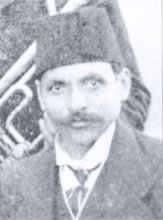 Nikolle Bojaxhiu, Father of Mother Teresa
Nikolle Bojaxhiu, Father of Mother Teresa
Nikolle Bojaxhiu was an active Albanian rights activist, businessman and the father of Mother Teresa. He married Dranafile Bernai with whom he had three children: Aga (b. 1905), Lazar (b. 1908) and Agnes (b. 1910), with Agnes became Mother Teresa. On the day of the Albanian Declaration of Independence from the Ottoman Empire on 28th November 1912, he hosted a meeting that was attended by famous Albanian leaders.
After the incorporation of his native region into Serbia during World War-1, Bojaxhiu joined various Albanian rights political organizations. He died in 1919, a few hours after he returned from a political meeting in Belgrade. Several biographers have attributed his death to poisoning by Serbian agents. His son Lazar considered the theory of poisoning to be a certainty, while his daughter Agnes (Mother Teresa) described it as unconfirmed.
His funeral process was attended by large numbers of people and representative of all the religious communities. As a sign of respect, that day all school children were given dedicatory handkerchiefs. After his death, his business partner appropriated the entirety of their companies' assets and left nothing to his widow and offspring.
Mother Teres’s father was a rights activist who fought against injustice in the society. He was also the only Catholic to be elected to the city council of Skopje. It is sure that the young Agnes got inspired from his father, traveled thousands of kilometers and fought against hunger of the deserted and oppressed people in India & other courtiers. Mother Teresa had said: “By blood, I am Albanian. By citizenship, an Indian. By faith, I am a Catholic nun. As to my calling, I belong to the world. As to my heart, I belong entirely to the heart of Jesus.”